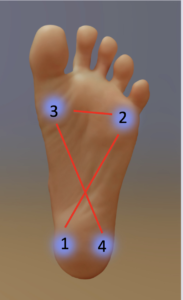
by Ellen Saltonstall
“The explanation we expect stability is related to longevity is as a result of it requires retaining your mind and nervous system’s integration circuitry intact.” —Danine Fruge, MD, family-practice doctor
Working towards particularly for higher stability is necessary for us at any age, however it’s important for these of us over 50 or 60, when so many modifications occur in our our bodies. To work on stability with yoga, Tree pose is a standard selection. Though Tree Pose is iconic, typically consultant of yoga typically, there are numerous different numerous and entertaining methods to enhance stability. With higher stability, we keep away from falls, which may result in accidents and a severe decline in general well being. On this submit I’ll describe to you a few of my prime decisions for practising primary stability abilities that can show you how to in every day life and in your Tree pose.
To get the unhealthy information out instantly, listed here are the commonest modifications that occur step by step as we age:
- Much less acuity within the nervous system (which may manifest as slower response time diminished coordination, diminished sensory and motor effectivity, and cognitive decline)
- Blood stress deviations from regular ranges
- BPPV: benign paroxysmal positional vertigo, through which small stones in internal ear change into dislodged, is frequent in over 60
- Diminished circulatory effectivity and diminished elasticity of blood vessels
- Peripheral neuropathy (poor nerve conduction within the fingers and ft)
- Lack of muscle power (referred to as sarcopenia) and stiffening of the connective tissues
- Lack of bone density (osteopenia or osteoporosis)
- Degeneration and stiffness of joints as a consequence of put on and tear (osteoarthritis)
- Poor stability, ensuing from the entire above
We’d like stability abilities to keep away from falling. In line with the Nationwide Council on Ageing, falling is the main reason behind deadly and nonfatal accidents amongst older adults. The most typical areas for these fractures are the hip, pelvis, ankle, wrist, and higher arm bone close to the shoulder.
To catch ourselves after we would possibly fall, we want flexibility and coordination to all of a sudden regain our stability. If we do fall, we want power to catch ourselves. Fall prevention should embody all of those components of balancing: power, flexibility, and coordination. And the bonus is that after we develop these abilities, we contribute to our agility in every day life. Doesn’t that additionally sound like the identical checklist as the advantages of a very good yoga observe?
Our Three Steadiness Mechanisms
We have now three mechanisms within the physique that work concurrently, second to second, to assist us preserve stability. Because the opening quote says, we want the mind and physique to be speaking to one another.
First, our proprioception sends neural indicators from our muscular tissues and joints to the mind that point out what place we’re in. For this to work effectively, we want ample physique consciousness and focus to obtain these indicators and make changes when wanted. Many older adults have diminished proprioception and presumably additionally peripheral neuropathy, which is an absence of sensation and motor management within the ft. Our ft might really feel numb or unable to maneuver within the methods their design permits. One other frequent growing older situation associated to proprioception is a normal slowing of perceptual and cognitive operate. We might not understand an impending lack of stability quickly sufficient to forestall a fall. However proof exhibits that these situations will be at the least partially reversed by common train. The mind can continue learning!
Secondly, the fragile constructions within the internal ear reply to modifications of place (significantly of the top) and talk with the mind. That is referred to as the vestibular system, and it modifications with the growing older course of.
Thirdly, our visible sense offers us a feeling-sense of orientation to gravity and the atmosphere round us. We have to keep in mind to take care of our consideration and our visible focus (each direct and peripheral), whether or not strolling on the road or doing any form of train. This will appear apparent, however you possibly can ask your self: how typically do I change into concerned with an inner reverie whereas doing my every day actions or whereas strolling exterior, both within the metropolis or within the nation? If that inattention turns into a persistent behavior, it could actually improve your danger of falling.
For those who all of a sudden develop a stability situation, akin to dizziness or light-headedness when going from mendacity right down to standing up, or when you’ve got diminished sensation in your ft, I like to recommend that you just search medical assist to think about internal ear, issues, neuropathy, treatment unintended effects, or cardiovascular points. Nevertheless, a gradual improvement of stability issues is almost certainly to be brought on by our regular growing older course of. That is the place yoga may help.
With yoga, you enhance your proprioception, you strengthen your muscular tissues, and also you improve your flexibility. I’ve talked about why proprioception and muscle power are necessary. However why flexibility? While you sense that your stability is off, the pure tendency is to regulate your place to regain your stability. This might be catching your self with one foot after tripping over an impediment or widening your stance whereas strolling down the aisle of a fast-moving prepare. In an effort to try this, you want quick responses, but in addition hip and leg mobility. Flexibility permits you a better vary of adaptive strikes to regular your self and stop a fall. Because of this, your yoga observe should embody workout routines for dynamic balancing, which I imagine is simply as necessary as studying to stability on one foot in stillness.
Alignment issues. What’s your private optimum posture, given all of the variations that exist in humanity? How do you have a tendency to rearrange your physique when standing, strolling, and doing all of your every day actions? I’ve seen some frequent non-optimal tendencies in my years of instructing, akin to turning the knees inward or the ft outward, pushing the pelvis ahead, sinking within the decrease or higher again, rolling the shoulders ahead, and carrying the top ahead with the neck shortening. Every of those deviations from optimum alignment can predispose us to dropping our stability.
I like to recommend that you just seek the advice of a skilled trainer that will help you consider your posture. However listed here are some primary tips:
- Your weight is effectively balanced in your ft. You place your ft with the middle line of 1 foot parallel to the middle line of the opposite foot. In case your behavior is to show your ft inward or outward, step by step work to change into extra acquainted with this impartial place of parallel ft. (See the 4 Corners train beneath.)
- Your knees face towards your center toes, whether or not your legs are bent or straight. (See the Knee Monitoring train beneath.)
- The lean of your pelvis is suitable on your physique and the pose you’re doing. Discover the midpoint between an extreme lumbar (decrease again) arch, and the alternative sample of excessively tucking your tailbone.
- You preserve stomach help, with out dropping the slight arch inward in your decrease again.
- Your entrance chest is lifted and broad, with the muscular tissues round your shoulder blades supporting your higher again.
- Your head aligns over your backbone as a lot as potential. For those who have a tendency to hold your head ahead, transfer your head again, first with the bottom of your ears shifting again, then lifting your chin to recuperate the slight arch in your neck.
- You enliven your complete physique with the power out of your breath and your highest intention on your well-being. Be absolutely current in your physique.
What’s “The Core” and Why is it Essential?
The prevailing definition of “core” is your stomach muscular tissues. Throughout the health and medical group, there’s a tendency to overemphasize stomach strengthening via sit-ups, crunches, or some variation of these frequent workout routines. For anybody with low bone density, any such train is harmful, as a result of it places extra stress on the entrance a part of the vertebrae as you curve your backbone.
However there may be one other method to perceive the core—to see it as together with the muscular tissues of the backbone, hips, pelvic ground, thighs, and the stomach wall. These core muscular tissues stabilize the center of our physique on all sides, making a supply and middle for the actions of the remainder of the physique. With a weak core, your physique will discover different, much less environment friendly methods for stability, akin to tensing your shoulders. With a robust core, you’ll have way more stability and help for any state of affairs, particularly vigorous actions—but in addition for every day chores or intensive sitting at work. And most of all, you’ll have higher stability.
One motion that could be unfamiliar to many individuals is the carry of the pelvic ground. It is a muscular community on the base of your pelvis that we use to stabilize our middle within the yoga poses. Proper now, as you’re studying, squeeze the muscular tissues there and see the way it feels. Discover that you could proceed to breathe whereas firming these muscular tissues. You may squeeze towards the middle, after which gently carry that ground upward. Apply this for 15 seconds at a time at first, after which step by step combine it into your observe.
Listed here are some workout routines that you are able to do as a warmup on your normal observe, with particular consideration to stability enchancment.
My favourite core strengthening yoga pose is a dynamic supine twist, a variation of Jathara Parivartanasana. I prefer it as a result of individuals or any age can do it, and all of the core muscular tissues are strengthened with out spinal flexion.
Supine Twist (Jathara Parivartanasana)
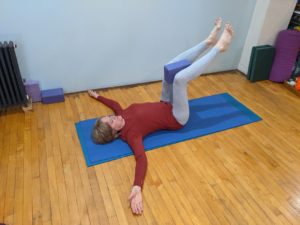
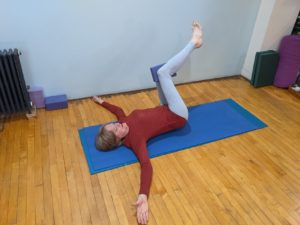
Objective: To strengthen the core muscular tissues of the backbone and torso, and be taught to twist with a protracted backbone
Props: Yoga mat and non-compulsory blanket underneath your pelvis or head and neck for consolation
Physique place: In your again, knees bent, arms stretched to the perimeters, palms dealing with up
Directions:
- Bend your knees and place a block between them (slender, medium, or extensive setting, your selection), retaining your ft at the least as excessive as your knees, or larger. Squeeze the block.
- Flex your ankles and unfold your toes.
- Press your arms and shoulders down into the mat to stabilize your higher torso.
- Transfer your legs at a average tempo from proper to left, respiratory easily. Start by shifting a small quantity and improve how far you twist as you are feeling prepared.
- When you find yourself drained, come again to middle, take away the block, place your ft flat, and relaxation.
Issues to look at for:
- Maintain your shoulders on the ground and spot the strengthening actions in your twisting muscular tissues (backbone and stomach). This is superb core work, since you are working dynamically via a variety of motion, whereas stabilizing.
- Discover that the ground lets you preserve a protracted backbone.
- Maintain your neck impartial: not urgent it down or lifting it up.
These three workout routines put together our knees, ankles, and ft to have the coordination and power to help us.
The 4 Corners of the Ft

Objective: To stability your weight effectively in your ft and strengthen the intrinsic foot muscular tissues.
Props: The ground
Physique place: Standing
Directions:
Start by standing in a “regular” method and really feel the stability of weight in your ft. Do you have a tendency to position extra weight on one foot compared to the opposite? Extra weight in a single a part of the foot?
Subsequent, work with one foot at a time within the following method:
- Put most of your weight on one foot. With the opposite one, tilt your foot in order that the internal heel is the one half touching the ground.
- Then maintain that half down and put the bottom of your little toe down (on the joint at its base). Discover how varied muscular tissues within the sole of your foot (referred to as intrinsic muscular tissues) are working as you do these steps.
- Maintaining these two factors down, widen throughout the forefoot to convey the bottom of your huge toe down. Discover the way it feels to widen your foot on this method.
- With these three factors staying down, press your outer heel down.
- Really feel how the burden balances on these 4 corners. You would possibly play with the 4 corners, shifting via the sequence like a dance. Experiment with balancing on that foot.
- Repeat this sequence together with your different foot.
Issues to look at for:
- How do your ft really feel totally different after doing this?
- Which corners are best so that you can discover and press down? That are much less simple?
- What does this let you know about your normal posture in your ft?
- What do you are feeling in your knees and hips as you do that?
Knee Monitoring
![]()
Objective: To align your knees effectively as they bend, for security, stability, and power within the poses
Props: The ground
Physique place: Standing
Directions:
- Stand together with your ft balanced on their 4 corners and place them hip-width aside.
- Bend your knees and look right down to see the place the kneecaps are pointing. Regulate them in order that they level towards the second or third toe.
- Apply this a number of occasions, observing the knees as they bend.
Issues to look at for:
- For many individuals, the knees might flip in towards the midline. What’s your routine sample?
- What do it’s important to do in another way than normal to align your knees on this method?
- The place in your physique do you are feeling the actions which can be wanted?
Heel Carry
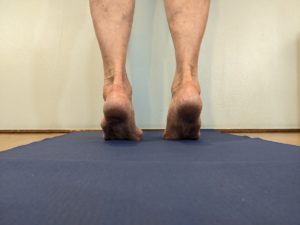
Objective: To strengthen the perimeters of the ankles for higher stability
Props: A wall or another floor you possibly can contact for stability help
Physique place: Stand dealing with the wall, touching it evenly together with your fingertips, or stand subsequent to a different help (a chair or desk)
Directions:
- Touching your help evenly for stability, carry your heels, coming onto your toes, particularly the primary three toes. Really feel the supportive motion of your ankle muscular tissues on each side, as you carry the heels straight up.
- Convey your heels again to the ground and repeat this motion a number of occasions till your muscular tissues fatigue.
- As soon as you’re snug with this heel carry, additionally unfold your toes.
Issues to look at for:
- Maintain your weight largely in your first three toes. If the burden strikes to the outer toes, the ankles will wing out, and you’ll lose the aim of the train.
The final train is a playful one, supplying you with the coordination it’s worthwhile to recuperate your stability earlier than you fall.
Dynamic Balancing
Objective: To simulate stability challenges in every day life
Props: A wall or chair again
Physique place: Standing
Directions for Half 1:
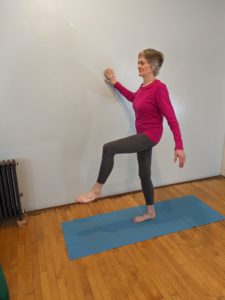
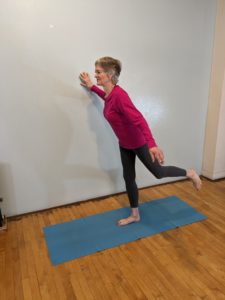
You are able to do this train whereas touching a wall or a chair, or free standing.
- From standing on two ft, convey your weight to at least one leg and swing the opposite leg gently ahead and again. Attempt totally different speeds.
- Focus your gaze strongly on one spot in entrance of you and interact your core to stabilize your stability.
- Convey the lifted leg down and repeat on the opposite aspect.
Directions for Half 2:
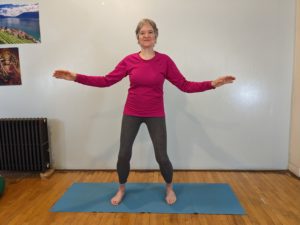
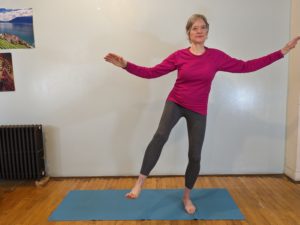
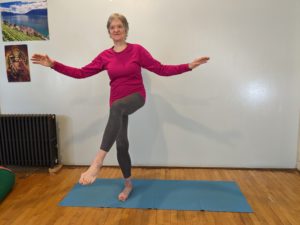
- Transfer away from the wall, and stand dealing with out into the room, with ft a number of inches aside in an effort to simply transfer aspect to aspect.
- Begin by lifting your proper foot and take a large sideward step to the correct, inserting your proper foot down and shifting your weight on the correct foot so your left foot is within the air. Leaving your left foot within the air, stability there for just a few seconds.
- Then convey the left foot down into one other extensive side-step, this time to the left. When you place your left foot down and shift your weight onto your left foot, maintain your proper foot within the air for just a few seconds. Then convey the correct foot down.
- Repeat this sample, various the space and the pace. Deal with how you discover and maintain your stability on one leg.
- Proceed for so long as you want.
Issues to look at for:
- Think about the power of your standing leg, and don’t fear about your look. The necessary factor is constructing your talent to recuperate your stability when it begins to go off middle. Be playful!
This submit is excerpted from my forthcoming e book tentatively titled “Yoga Apply Information for Constructing Robust Bones and Bettering Steadiness,” to be printed by Emerald Lake Books in fall of 2023. Go to ellensaltonstall.com
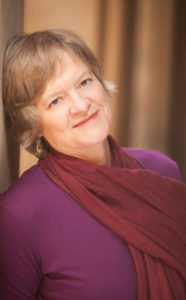 Ellen Saltonstall, ERYT-500, C-IAYT, YACEP is an alignment-based yoga teacher and physique therapist based mostly in New York Metropolis with over 40 years of expertise. Her background contains trendy dance, a therapeutic massage remedy observe, Iyengar Yoga and Anusara Yoga. She was licensed in Anusara Yoga in 2001, then turned a Topic Matter Specialist in anatomy and therapeutics. Along with yoga, she teaches Bodymind Ballwork, a technique of bodywork utilizing rubber balls to facilitate stress launch. Her printed books embody Yoga for Arthritis (2008), Yoga for Osteoporosis (2010), Anatomy and Yoga (2016), and The Bodymind Ballwork Technique (2018). She provides yoga remedy webinars via YogaOnlineU.com, and she or he teaches nationally and internationally with a specialty in anatomy and therapeutics. She is understood for her readability, depth of data, and enthusiasm in encouraging college students of all ranges to search out freedom and pleasure via yoga. Extra data right here.
Ellen Saltonstall, ERYT-500, C-IAYT, YACEP is an alignment-based yoga teacher and physique therapist based mostly in New York Metropolis with over 40 years of expertise. Her background contains trendy dance, a therapeutic massage remedy observe, Iyengar Yoga and Anusara Yoga. She was licensed in Anusara Yoga in 2001, then turned a Topic Matter Specialist in anatomy and therapeutics. Along with yoga, she teaches Bodymind Ballwork, a technique of bodywork utilizing rubber balls to facilitate stress launch. Her printed books embody Yoga for Arthritis (2008), Yoga for Osteoporosis (2010), Anatomy and Yoga (2016), and The Bodymind Ballwork Technique (2018). She provides yoga remedy webinars via YogaOnlineU.com, and she or he teaches nationally and internationally with a specialty in anatomy and therapeutics. She is understood for her readability, depth of data, and enthusiasm in encouraging college students of all ranges to search out freedom and pleasure via yoga. Extra data right here.
• Comply with Yoga for Wholesome Ageing on Fb and observe Nina on Instagram • Order Yoga for Occasions of Change right here and buy the companion movies right here • Order Yoga for Wholesome Ageing: A Information to Lifelong Effectively-Being right here.

